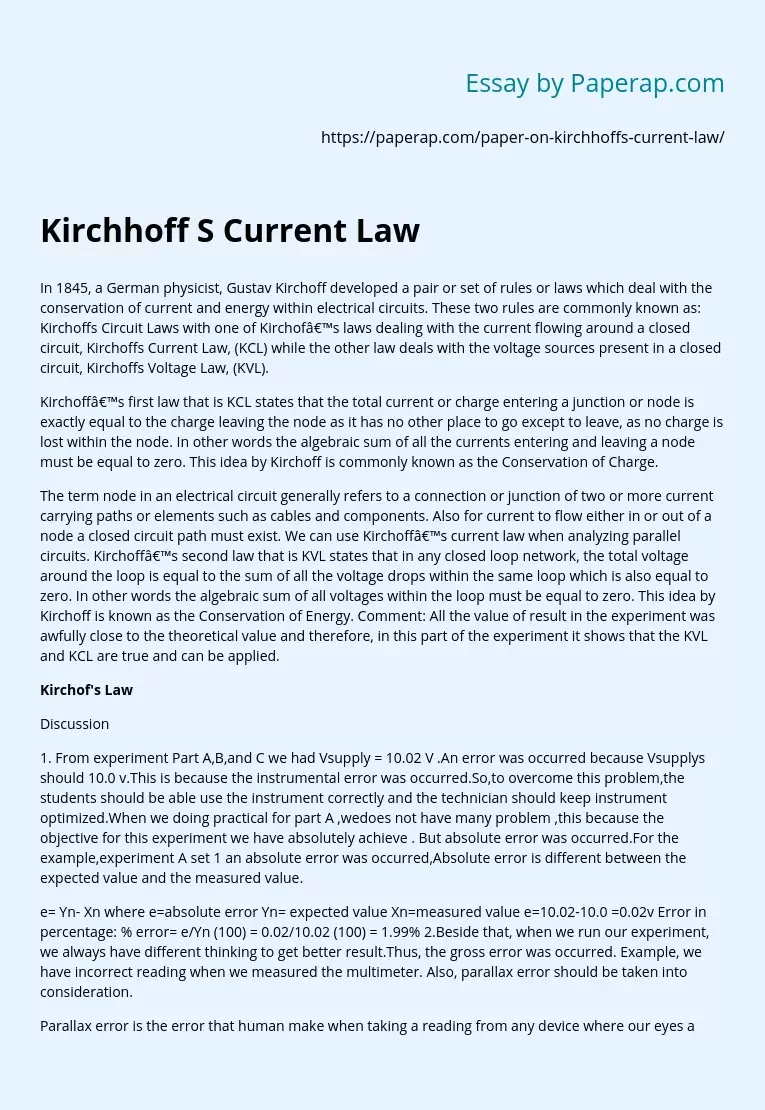Kirchhoff S Current Law
In 1845, a German physicist, Gustav Kirchoff developed a pair or set of rules or laws which deal with the conservation of current and energy within electrical circuits. These two rules are commonly known as: Kirchoffs Circuit Laws with one of Kirchof’s laws dealing with the current flowing around a closed circuit, Kirchoffs Current Law, (KCL) while the other law deals with the voltage sources present in a closed circuit, Kirchoffs Voltage Law, (KVL).
Kirchoff’s first law that is KCL states that the total current or charge entering a junction or node is exactly equal to the charge leaving the node as it has no other place to go except to leave, as no charge is lost within the node.
In other words the algebraic sum of all the currents entering and leaving a node must be equal to zero.
This idea by Kirchoff is commonly known as the Conservation of Charge.
The term node in an electrical circuit generally refers to a connection or junction of two or more current carrying paths or elements such as cables and components.
Also for current to flow either in or out of a node a closed circuit path must exist. We can use Kirchoff’s current law when analyzing parallel circuits. Kirchoff’s second law that is KVL states that in any closed loop network, the total voltage around the loop is equal to the sum of all the voltage drops within the same loop which is also equal to zero. In other words the algebraic sum of all voltages within the loop must be equal to zero. This idea by Kirchoff is known as the Conservation of Energy. Comment: All the value of result in the experiment was awfully close to the theoretical value and therefore, in this part of the experiment it shows that the KVL and KCL are true and can be applied.
Kirchof’s Law
Discussion
1. From experiment Part A,B,and C we had Vsupply = 10.02 V .An error was occurred because Vsupplys should 10.0 v.This is because the instrumental error was occurred.So,to overcome this problem,the students should be able use the instrument correctly and the technician should keep instrument optimized.When we doing practical for part A ,wedoes not have many problem ,this because the objective for this experiment we have absolutely achieve . But absolute error was occurred.For the example,experiment A set 1 an absolute error was occurred,Absolute error is different between the expected value and the measured value.
e= Yn- Xn where e=absolute error Yn= expected value Xn=measured value e=10.02-10.0 =0.02v Error in percentage: % error= e/Yn (100) = 0.02/10.02 (100) = 1.99% 2.Beside that, when we run our experiment, we always have different thinking to get better result.Thus, the gross error was occurred. Example, we have incorrect reading when we measured the multimeter. Also, parallax error should be taken into consideration.
Parallax error is the error that human make when taking a reading from any device where our eyes are not perpendicular to the scale reading. To overcome this problem, we carefully read the scale reading to minimize any fault. 3.Next, the problem that our group have come to face is incorrect reading of the multimeter, voltmeter and ammeter. We suspected that the fault was caused by the instrument itself. To overcome this problem, we take at least three separate reading to obtain better reading. Conclusion From the experiment that we had conducted, we had practically use Kirchoff Law to determine the voltage drop, voltage supplied, current for each resistor in series and parallel circuit.
References
Kirchhoff S Current Law. (2019, Dec 05). Retrieved from https://paperap.com/paper-on-kirchhoffs-current-law/

